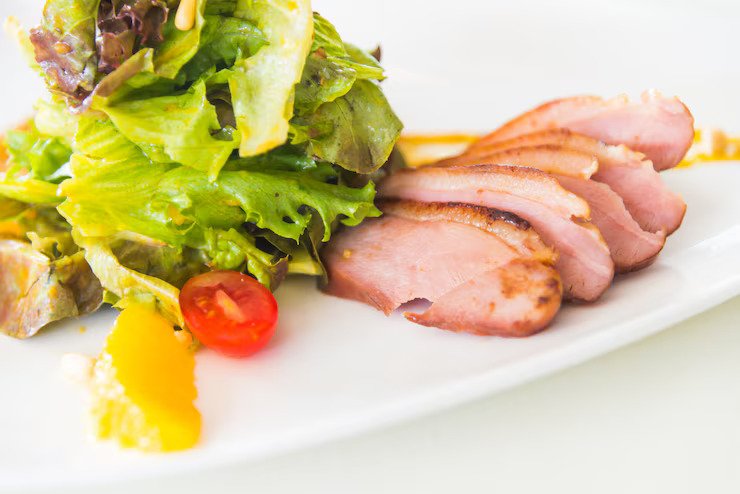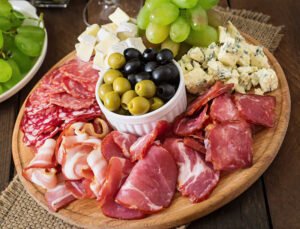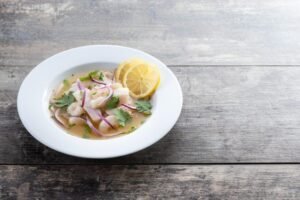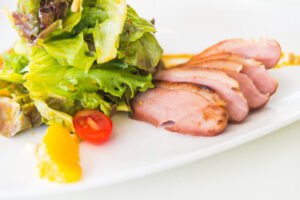Judd Mat Gaardebounen, a celebrated dish of Luxembourg, has long been a cornerstone of the country’s culinary identity. Known for its rich textures and robust flavors, this dish brings together the finest elements of local gastronomy. The key component of this traditional meal is smoked collar of pork, a cut known for its tender and juicy qualities, which is meticulously prepared to perfection. This pork is often accompanied by mustard or horseradish, offering a blend of smoky, savory, and earthy flavors that create a harmonious balance on the palate.
The preparation of Judd Mat Gaardebounen is both an art and a testament to Luxembourg’s agricultural bounty. The dish is traditionally served with broad beans, locally known as ‘Gaardebounen,’ which are boiled to a tender consistency. These beans, when combined with the rich pork, create a satisfying contrast in texture and flavor. The choice of mustard or horseradish as an accompaniment not only adds a piquant punch but also enhances the depth of the dish, making each bite a unique experience.
For those interested in recreating this dish at home, it’s essential to source high-quality ingredients. Look for fresh, organic broad beans and a well-marbled cut of pork collar that has been properly smoked. A carefully selected mustard or horseradish will augment the dish’s complexity, providing a spicy counterpoint to the mild sweetness of the beans and the savory richness of the pork. Whether enjoyed in a rustic home setting or a sophisticated urban eatery, Judd Mat Gaardebounen remains an enduring symbol of Luxembourg’s culinary heritage, celebrated for its comforting and hearty nature.
The Heart of Luxembourg’s Beloved Dish: Pork and Beans
Judd mat Gaardebounen, a cherished culinary tradition in Luxembourg, is a dish that embodies the rich flavors and cultural heritage of the region. At its core, this hearty meal features a savory combination of smoked pork collar and broad beans. The pork is typically cured and smoked, infusing the dish with a deep, smoky flavor that serves as the perfect counterbalance to the natural earthiness of the beans. This combination is often accompanied by mustard or horseradish, which offers a blend of smoky, savory, and earthy flavors, enhancing every bite with a tangy, piquant edge.
Preparing Judd mat Gaardebounen requires a thoughtful selection of ingredients and a commitment to traditional cooking techniques. The pork, known as Judd, is typically sourced from high-quality cuts, ensuring tenderness and flavor. It is carefully cured and smoked, often using local woods to impart a distinctive taste that is both robust and nuanced. The beans, or Gaardebounen, are usually freshly shelled, their creamy texture providing a satisfying contrast to the meat. As they simmer together, the beans absorb the smoky essence of the pork, resulting in a harmonious blend of flavors that is both comforting and complex.
To accompany this dish, a selection of sides and condiments is often employed to further elevate the experience. Mustard, with its sharp and tangy profile, is a popular choice, cutting through the richness of the pork with its own assertive flavor. Horseradish, on the other hand, offers a fiery kick, infusing the dish with a burst of heat that complements the savory components. These condiments not only add depth but also provide a delightful contrast, highlighting the dish’s intricate flavor profile.
For those seeking to recreate Judd mat Gaardebounen at home, attention to detail is key. From the choice of pork collar to the careful selection of beans, each element must be chosen with care to ensure authenticity. The curing and smoking process, although time-intensive, is crucial for developing the dish’s signature taste. Serving the dish with a generous helping of mustard or horseradish is recommended, allowing diners to tailor their experience to their personal taste preferences. By honoring the traditional methods and using quality ingredients, one can capture the essence of this beloved Luxembourgish dish in its full glory.
Seasoning Secrets: Traditional Herbs and Spices
In the culinary tradition of Judd Mat Gaardebounen, seasoning plays a pivotal role in crafting its distinctive taste. This dish, deeply rooted in Luxembourgish cuisine, is a testament to the region’s rich tapestry of flavors. The seasonings used are not merely an afterthought but an integral component that elevates the dish to a culinary masterpiece. The selection of herbs and spices is meticulously curated, bringing out the best in the smoked collar of pork and broad beans.
At the core of its seasoning are traditional herbs such as bay leaves and thyme. These herbs impart a subtle earthiness and depth to the dish, enhancing its savory profile. Bay leaves provide a mild, slightly floral fragrance, while thyme contributes a hint of mint and lemon notes, creating a balanced flavor foundation. These herbs are often accompanied by mustard or horseradish, offering a blend of smoky, savory, and earthy flavors that complement the pork’s richness.
The use of spices in Judd Mat Gaardebounen is equally deliberate. Black peppercorns add a gentle heat and pungency that cut through the dish’s meaty character. Their intensity is carefully calibrated to ensure they enhance rather than overpower the other flavors. Allspice, another key component, introduces a warm, clove-like aroma that rounds out the seasoning profile, adding complexity and nuance.
To achieve the perfect seasoning balance, consider the following steps:
- Infuse the Stock: As the pork simmers, add bay leaves and thyme to the stock to allow their flavors to infuse deeply into the meat.
- Use Fresh Herbs: Whenever possible, opt for fresh bay leaves and thyme. Their oils are more potent and can impart a fresher taste.
- Grind Spices Fresh: Freshly grinding black peppercorns and allspice can significantly enhance their aromatic qualities.
- Adjust to Taste: Taste the dish as it cooks, adjusting the amount of mustard or horseradish to achieve the desired level of piquancy.
The mastery of seasoning in Judd Mat Gaardebounen is an art form passed down through generations, each iteration subtly different yet unmistakably authentic. The harmonious blend of traditional herbs and spices not only pays homage to the cultural heritage of Luxembourg but also delights the palate with every bite. By embracing these seasoning secrets, one can truly appreciate the depth and character that define this beloved dish.
A Culinary Journey: The Cooking Process of Judd Mat Gaardebounen
Judd mat Gaardebounen, a cherished Luxembourgish dish, encapsulates a rich tapestry of traditional flavors and techniques. At the heart of this dish lies the smoked pork neck, an ingredient that demands patience and attention. The process begins with an overnight soak, a crucial step that allows the meat to tenderize and any excess salt to be drawn out, ensuring a perfectly balanced flavor profile. As the pork neck absorbs the water, it becomes a canvas ready to be infused with the aromatic notes of bay leaves and cloves.
Once soaked, the next stage involves simmering the meat in a gentle bath of water, along with the fragrant bay leaves and cloves. This slow cooking process, which can take several hours, is essential for achieving the desired tenderness and depth of flavor. The key is to maintain a low, steady heat, allowing the flavors to meld without rushing the transformation. The aroma that fills the kitchen during this time is a prelude to the comforting meal that awaits.
Pairing with Traditional Sides
The hallmark of Judd mat Gaardebounen is its harmonious pairing with broad beans and boiled potatoes, creating a dish that is as satisfying as it is flavorful. The broad beans, cooked until just tender, provide a vibrant contrast in both color and texture. Meanwhile, the boiled potatoes serve as a hearty counterpart, their subtle earthiness complementing the robust flavors of the smoked pork. When serving, the pork is sliced into thick pieces, each bite revealing the intricate layers of flavor developed during the simmering process.
Serving and Presentation
To present Judd mat Gaardebounen, arrange the pork slices alongside a generous portion of broad beans and potatoes. The dish is often enhanced with a drizzle of the cooking broth, which adds an additional layer of moisture and seasoning. This traditional dish, when presented with care, not only pleases the palate but also pays homage to Luxembourg’s rich culinary heritage. Each element of the dish plays a crucial role, weaving together to create a meal that is both simple and profoundly satisfying.
Where to Experience Authentic Judd Mat Gaardebounen
For those seeking a genuine taste of Luxembourg’s culinary tradition, Judd Mat Gaardebounen represents an essential dish, deeply rooted in the country’s culture. This hearty meal, featuring smoked pork collar served alongside broad beans, is often accompanied by mustard or horseradish, offering a blend of smoky, savory, and earthy flavors that captures the essence of Luxembourgish cuisine. Finding the most authentic experience requires visiting establishments known for their dedication to preserving the traditional methods of preparation and using locally sourced ingredients.
One of the best places to experience Judd Mat Gaardebounen is in the heart of Luxembourg City, where several bistros and restaurants offer this traditional dish with a modern twist. At Restaurant Am Tiirmschen, located in the historic Grund district, the chefs pride themselves on preparing Judd Mat Gaardebounen using time-honored techniques and regional produce. Their version is noted for its tender meat and perfectly cooked beans, creating a harmonious balance with the sharpness of the accompanying condiments.
Luxembourg’s Countryside: A Culinary Journey
For a truly immersive experience, venturing into the Luxembourg countryside can be rewarding. The village of Schengen, famously known for the Schengen Agreement, also hosts eateries that serve Judd Mat Gaardebounen in a rustic setting. Here, the dish is often enjoyed in communal dining settings, allowing diners to savor the meal as locals do. The use of traditional cooking methods, such as slow-smoking the pork, enhances the depth of flavor, making it a must-try for any culinary enthusiast visiting the area.
In addition, the town of Echternach, nestled along the border with Germany, offers a unique perspective on this dish. At local establishments, Judd Mat Gaardebounen is crafted with a nod to cross-border influences, subtly incorporating elements from neighboring culinary traditions. This results in a variant that maintains the core identity of the dish while introducing nuances that distinguish it from its purely traditional counterparts.
Seasonal Celebrations and Markets
Beyond restaurants, Luxembourg’s seasonal markets and food festivals provide an excellent opportunity to taste Judd Mat Gaardebounen. During the Eimaischen festival, held annually in April, the streets of Luxembourg City come alive with stalls offering this traditional dish, among other local specialties. These events not only celebrate the rich culinary heritage of the region but also allow visitors to experience the communal joy that accompanies sharing a meal steeped in history. The vibrant atmosphere and the emphasis on local flavors make these festivals an ideal venue to indulge in Judd Mat Gaardebounen.










